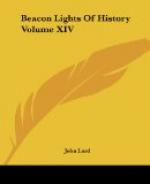“To us the future’s
all unknown;
In
memory seek relief.
Come, touch the
chords you know so well,
And
let them soothe our grief.”
II.
INTERCOURSE BY SEA.
In 1388 the Mongols were expelled. The Christian bishopric was swept away, and left no trace; but a book of the younger Polo, describing the wealth of China, gave rise to marvellous results. Together with the magnetic needle, which originated in China, it led to centuries of effort to open a way by sea to that far-off fairyland. It was from Marco Polo that Columbus derived his inspiration to seek a short road to the far East by steering to the West,—finding a new world athwart his pathway. It was the same needle, if not the same book, that impelled Vasco da Gama to push his way across the Indian Ocean, after the Cape of Good Hope had been doubled by Bartholomew Diaz. A century later the same book led Henry Hudson to search for some inlet or strait that might open a way to China, when, instead of it, he discovered the port of New York.
The mariner’s compass, which wrought this revolution on the map of the world, is only one of many discoveries made by the ancient Chinese, which, unfruitful in their native land, have, after a change of climate, transformed the face of the globe.
The polarity of the loadstone was observed in China over a thousand years before the Christian era. One of their emperors, it is said, provided certain foreign ambassadors with “south-pointing chariots,” so that they might not go astray on their way home. To this day the magnetic needle in China continues to be called by a name which means that it points to the south. It heads a long list of contraries in the notions of the Chinese as compared with our own, such, for example, as beginning to read at the back of a book; placing the seat of honor on the left hand; keeping to the left in passing on the street, with many others, so numerous as to suggest that the same law that placed their feet opposite to ours must have turned their heads the other way. To the Chinese the “south-pointing needle” continued to be a mere plaything to be seen every day in the sedan chair of a mandarin, or in wheeled vehicles. If employed on the water, it was only used in coasting voyages.
So with gunpowder, of which the Arabs were transmitters, not inventors. In other lands it revolutionized the art of war, clothing their people with irresistible might, while in its native home it remained undeveloped and served chiefly for fireworks. Have we not seen, even in this our day, the rank and file of the Chinese army equipped with bows and arrows? The few who were provided with firearms, for want of gunlocks, had to set them off by a slow-match of burning tow; and cannon, meant to guard the mouth of the Peiho, were trained on the channel and fixed on immovable frames.




